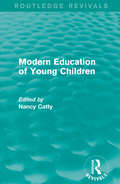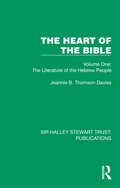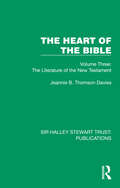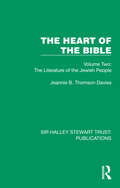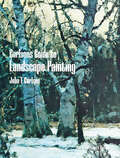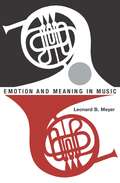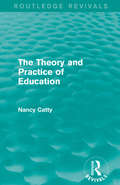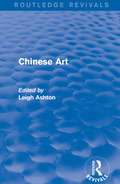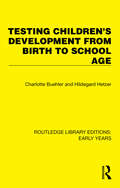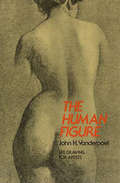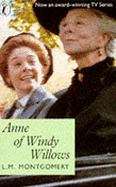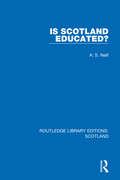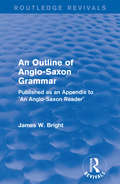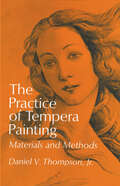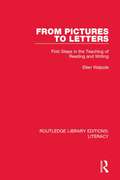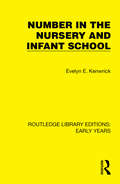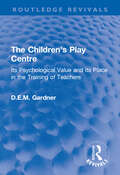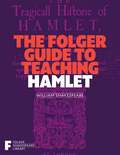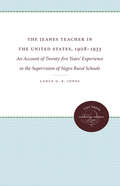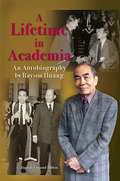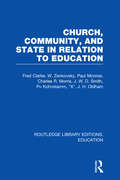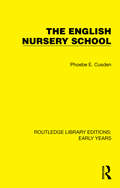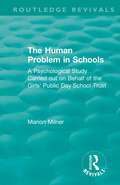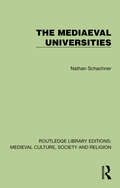- Table View
- List View
Modern Education of Young Children (Routledge Revivals)
by Nancy CattyFirst published in 1933, experienced teachers describe the transition in a large infant school from formal teaching to project work and illustrate the methods by which children, free to play singly or in groups, gain general education and rapidly acquire skill in the three R's. That similar methods can be used successfully in the teaching of separate subjects is illustrated in the chapters on the teaching of geography, music and nature study, written by teachers of kindergarten and lower forms. Throughout the underlying principles are made clear so that teachers and students will easily be able to apply them to their own branch of work in their own type of school.
My Life And Hard Times
by James ThurberIn this autobiography Mr. Thurber's daring typewriter and unbridled drawing pencil have combined to glean his teeming life. In chapter one he tells what happened the night the bed fell on his father.
The Heart of the Bible: Volume One: The Literature of the Hebrew People (Sir Halley Stewart Trust: Publications)
by Jeannie B. Thomson DaviesOriginally published in 1933, from the preface: “The aim of this particular venture is to present the writings now collected in the volume called the Bible in an order approaching that in which they came into being. The hope is that a considerable amount of both the Old and New Testaments may be read in a fresh setting, so that questions about inconsistencies in the Bible, or about its varying levels of morality, or about its uneven value for religious education can no longer be fired as poison darts to attack its life and influence…. This is an attempt to combine reading the Bible with learning to understand it.” Of particular relevance to those interested in religious studies, today it can be read in its historical context.This book is a re-issue originally published in 1933. The language used and views portrayed are a reflection of its era and no offence is meant by the Publishers to any reader by this re-publication.
The Heart of the Bible: Volume Three: The Literature of the New Testament (Sir Halley Stewart Trust: Publications)
by Jeannie B. Thomson DaviesOriginally published in 1933, from the volume one preface: “The aim of this particular venture is to present the writings now collected in the volume called the Bible in an order approaching that in which they came into being. The hope is that a considerable amount of both the Old and New Testaments may be read in a fresh setting, so that questions about inconsistencies in the Bible, or about its varying levels of morality, or about its uneven value for religious education can no longer be fired as poison darts to attack its life and influence…. This is an attempt to combine reading the Bible with learning to understand it.” Of particular relevance to those interested in religious studies, today it can be read in its historical context.This book is a re-issue originally published in 1933. The language used and views portrayed are a reflection of its era and no offence is meant by the Publishers to any reader by this re-publication.
The Heart of the Bible: Volume Two: The Literature of the Jewish People (Sir Halley Stewart Trust: Publications)
by Jeannie B. Thomson DaviesOriginally published in 1933, from the preface in volume one: “The aim of this particular venture is to present the writings now collected in the volume called the Bible in an order approaching that in which they came into being. The hope is that a considerable amount of both the Old and New Testaments may be read in a fresh setting, so that questions about inconsistencies in the Bible, or about its varying levels of morality, or about its uneven value for religious education can no longer be fired as poison darts to attack its life and influence…. This is an attempt to combine reading the Bible with learning to understand it.” Of particular relevance to those interested in religious studies, today it can be read in its historical context.This book is a re-issue originally published in 1933. The language used and views portrayed are a reflection of its era and no offence is meant by the Publishers to any reader by this re-publication.
Carlson's Guide to Landscape Painting (Dover Art Instruction)
by John F. CarlsonWritten by a famous American painter and teacher, whose landscapes are found in many of the world's most noted museums, this book is known as one of the art students' most helpful guides. It provides a wealth of advice on the choice of subject; it tells what to look for and aim for, and explains the mysteries of color, atmospheric conditions, and other phenomena to be found in nature. Through his profound understanding of the physical nature of landscapes and his highly developed artistic sense, John Carlson is able to explain both the whys and the hows of the various aspects of landscape painting. Among the subjects covered are angles and consequent values (an insightful concept necessary for strong overall unity of design), aerial and linear perspective, the painting of trees, the emotional properties of line and mass in composition, light, unity of tone, choice of subject, and memory work. In the beginning chapters, the author tells how to make the best of canvas, palette, colors, brushes, and other materials and gives valuable advice about texture, glazing, varnishing, bleaching, retouching, and framing. Thirty-four reproductions of Mr. Carlson's own work and 58 of his explanatory diagrams are shown on pages adjoining the text. As Howard Simon says in the introduction: "Crammed into its pages are the thoughts and experiences of a lifetime of painting and teaching. Undoubtedly it is a good book for the beginner, but the old hand at art will appreciate its honesty and broadness of viewpoint. It confines itself to the mechanics of landscape painting but, philosophically, it roams far and wide. . . . This is a book to keep, to read at leisure, and to look into for the solution of problems as they arise, when the need for an experienced hand is felt."
Emotion and Meaning in Music
by Leonard B. Meyer"Altogether it is a book that should be required reading for any student of music, be he composer, performer, or theorist. It clears the air of many confused notions . . . and lays the groundwork for exhaustive study of the basic problem of music theory and aesthetics, the relationship between pattern and meaning."—David Kraehenbuehl, Journal of Music Theory "This is the best study of its kind to have come to the attention of this reviewer."—Jules Wolffers, The Christian Science Monitor "It is not too much to say that his approach provides a basis for the meaningful discussion of emotion and meaning in all art."—David P. McAllester, American Anthropologist "A book which should be read by all who want deeper insights into music listening, performing, and composing."—Marcus G. Raskin, Chicago Review
The Theory and Practice of Education (Routledge Revivals)
by Nancy CattyOriginally published in 1934, this book provides the findings of psychologists which have direct bearing on the theory and practice of education, and shows the close connection between sound theory and methods of school organization and teaching. This connection is illustrated by constant application of general principles to practice, and much help is given towards the solution of the problems of the teacher, for example: learning through self-initiated constructive work; class teaching and individual study; training in social ethics; the growth of character; and the place of knowledge and craftsmanship in the curriculum.
Routledge Revivals: Chinese Art (1935)
by Leigh AshtonFirst published in 1935, this book was intended to provide westerners with a more definite and comprehensive understanding of Chinese Art and its achievements. Newly available opportunities to study authentic examples, such as the Royal Academy exhibition that provided the impetus for this volume, allowed for greater opportunities to conduct in-depth examination than had previously been possible. Following an introduction giving an overview of Chinese art and its history in the west, six chapters cover painting and calligraphy, sculpture and lacquer, ‘the potter’s art’, bronzes and cloisonné enamel, jades, and textiles — supplemented by a chronology of Chinese epochs, a selected bibliography and 25 images.
Testing Children's Development from Birth to School Age (Routledge Library Editions: Early Years)
by Charlotte Buehler Hildegard HetzerOriginally published in 1935, Testing Children's Development from Birth to School Age highlighted the greatly increased interest in measuring the development of pre-school children by other means than the older, inadequate "intelligence tests". In the early part of the twentieth century the work done at the Psychological Institute of the University of Vienna under the general direction of Dr Karl Buehler had become favourably known throughout Europe and the United States. This was also especially true of the studies in child psychology directed by the authors Dr Charlotte Buehler and her one-time assistant, Dr Hildegard Hetzer. The book contains developmental tests for the first six years of life; techniques for testing small children; information on the construction of tests and the evaluation their results. Today it can be read and enjoyed in its historical context.
The Human Figure
by John H. VanderpoelThis great classic is still unrivalled for its clear, detailed presentation of thousands of fundamental features of the human figure. Every element of the body (such as the overhang of the upper lip; the puckering at the corners of the mouth; the characteristic proportions of the head, trunk, limbs, etc.; the tension between connected portions of the body; etc.) is carefully and concisely pointed out in the text. Even more helpful are the 430 pencil and charcoal drawings that illustrate each feature so that you are, in effect, shown what to look for by a master teacher. The result is the only art instruction book which not only illustrates details of the body but directs your attention at every stage to a host of subtle points of shading, curvature, proportion, foreshortening, muscular tension, variations due to extreme age or youth, and both major and minor differences in the structure and representation of the male and female figure. Comprehensive discussions and drawings cover the eyes; nose, mouth and chin; ear; head, trunk, back and hips; neck, throat, and shoulder; shoulder and arm; hand and wrist; leg; foot; the complete figure; and other interdependent groups of structures. This is the human figure as the artist, art student, and art teacher must know it in order to avoid many deceptive errors unfortunately common in much modern portraiture, painting, and illustrative art.
Anne of Windy Willows
by L. M. MontgomeryThere are just two kinds of people in Summerside: those who are Pringles and those who aren't. Anne Shirley, the red-haired girl from Green Gables, has now grown into a young woman and her romance with Gilbert Blythe begins to flourish. There are important developments in her career too, for Anne is now Principal of Summerside High School. But life is not easy at the school, and it needs all Anne's courage, diplomacy and natural high spirits to overcome the prejudice of the locals and, more particularly, the Pringles the family that virtually rules the town and the surrounding countryside.
Is Scotland Educated? (Routledge Library Editions: Scotland #21)
by A. S. NeillOriginally published in 1936, and with more than a slightly tongue-in-cheek tone at times, the author of this book declares that Scotland is not educated but merely learned. This book does not deal with education in its narrowest sense: it ranges from the Kirk to Haggis, Tartans and Burns, Whisky and repressed sex in its discussion, proclaiming Calvinism as the root of most of Scotland’s evils. Honest and at times provocative, this volume does give direct access to the emotional roots of Neill’s feelings about Scottish education.
Routledge Revivals (1936): Published as an Appendix to "An Anglo-Saxon Reader"
by James W. BrightFirst published in 1936, this book is intended to provide an outline of Anglo-Saxon grammar for beginners, focusing on well-selected, succinctly stated rules rather than giving a detailed survey. It focuses on the West-Saxon dialect as this is best suited to beginners due to its uniformity in phonology and inflection, the fact it forms the basis of Anglo-Saxon grammar, and its prominence in the extant literature. Extracts have been selected from this literature to provide a sufficient basis, via the study of the easier to grasp later form of the dialect, to prepare the reader for the more difficult early West-Saxon dialect and further chronological study of the texts.
The Practice of Tempera Painting: Materials and Methods (Dover Art Instruction)
by Daniel V. ThompsonTempera painting, the method in which colors are mixed with some binding material other than oil (primarily egg yolk), is the earliest type of painting known to man. The wall paintings of ancient Egypt and Babylon are tempera, as are many of the paintings of Giotto, Lippi, Botticelli, Raphael, Titian, Tintoretto, and many other masters. But in spite of the time-proven excellence of this technique -- which boasts many clear advantages over oil paint -- it does not receive the degree of attention from modern painters that it deserves.Part of the explanation for this neglect, surely, is the absence of sufficient information about the materials and procedures involved in tempera painting. The present volume, in fact, is virtually the only complete, authoritative, step-by-step treatment of the subject in the English language, D.V. Thompson wrote this book after an exhaustive study, over many years, of countless medieval and Renaissance manuscripts in the British Museum and elsewhere, and is unquestionably the world's leading authority on tempera materials and processes.Beginning with an introductory chapter on the uses and limitations of tempera, the author covers such topics as the choice of material for the panel; propensities of various woods; preparing the panel for gilding; making the gesso mixture; methods of applying the gesso; planning the design of a tempera painting; use of tinted papers; application of metals to the panel; tools for gliding; handling and laying gold; combination gold and silver leafing; pigments and brushes; choice of palette; mixing the tempera; tempering and handling the colors; techniques of the actual painting; mordant gilding; permanence of tempera painting; varnishing; and artificial emulsion painting. The drawings and diagrams, illustrating the various materials and techniques, infinitely increase the clarity of the discussions. As a careful exposition of all aspects of authentic tempera painting, including many of the possible modern uses for this ancient method, this book actually stands alone. No one who is interested in tempera painting as a serious pursuit can afford to be without it.
From Pictures to Letters: First Steps in the Teaching of Reading and Writing (Routledge Library Editions: Literacy #23)
by Ellen WalpoleOriginally published in 1937. This book is ‘an account of the special training necessary for the young boy or girl in letter-making and simple reading’. The book uses ‘Basic English’, the 850 words of which are included specifically for reference, as a suggested starting point for the teaching of reading and writing, and presents a system for teachers to teach letters by pictures. The order of the letters in the main section of the book is from simplest form to most difficult with a later section showing them in alphabetical order. This is a superb insight into educational history and a fascinating early explanation of a now common method.
Number in the Nursery and Infant School (Routledge Library Editions: Early Years)
by Evelyn E. KenwrickOriginally published in 1937, Number in the Nursery and Infant School surveys the teachings of Froebel, Montessori and Dewey, the prevalent theories in education at the time, and takes elements from each in order to outline a new method. The author was closely associated with infant-school work over a number of years. She also trained teachers for that purpose, carefully observing the results of different methods of teaching. The method described was in full accord with modern psychological theory of the time, today it can be read and enjoyed in its historical context.
The Children's Play Centre: Its Psychological Value and its Place in the Training of Teachers (Routledge Revivals)
by D.E.M. GardnerFirst published in 1937, The Children’s Play Centre is an account of Gardner’s Play Centre and her work in assessing its value in the education of children and the training of teachers. The book puts forward the value of play in the development of children and provides a detailed report of Gardner’s experiment. It also explores the significance of the Play Centre to the technique of training students. It will have lasting relevance for those interested in the history of education and the psychology of education.
The Folger Guide to Teaching Hamlet (Folger Shakespeare Library)
by Peggy O'BrienCreated by experts from the world&’s largest and most well-respected Shakespeare archive, The Folger Guide to Teaching Hamlet provides an innovative approach to teaching and understanding one of Shakespeare&’s most well-known plays.Hamlet follows the form of a revenge tragedy, in which the hero, Hamlet, seeks vengeance against the man he learns is his father&’s murderer—his uncle Claudius, now the king of Denmark. Much of its fascination, however, lies in its mysteries. Among them: Should Hamlet believe a ghost? What roles do Ophelia and her family play in Hamlet&’s attempts to know the truth? Was his mother, Gertrude, unfaithful to her husband or complicit in his murder, or both? How do the visiting actors cause the truth to begin to reveal itself? The Folger Guides to Teaching Shakespeare series is created by the experts at the Folger Shakespeare Library, the nation&’s largest archive of Shakespeare material and a leading center for both the latest scholarship and education on all things Shakespeare. Based on the proven Folger Method of teaching and informed by the wit, wisdom, and experiences of classroom teachers across the country, the guides offer a lively, interactive approach to teaching and learning Shakespeare, offering students and readers of all backgrounds and abilities a pathway to discovering the richness and diversity of Shakespeare&’s world. Filled with surprising facts about Shakespeare, insightful essays by scholars, and a day-by-day, five-week teaching plan, these guides are an invaluable resource for teachers, students, and Shakespeare fans alike.
The Jeanes Teacher in the United States, 1908-1933: An Account of Twenty-Five Years' Experience in the Supervision of Negro Rural Schools
by Lance G. JonesMost educators have heard of the Jeanes Teachers and know something of their work as supervisors of black rural schools in the southern states. The present volume--historical, descriptive, and critical--is an account of the Jeanes movement from its inception down to 1933. Here is an excellent answer to the question of what can be done for Afro-American education in the rural South.Originally published in 1937.A UNC Press Enduring Edition -- UNC Press Enduring Editions use the latest in digital technology to make available again books from our distinguished backlist that were previously out of print. These editions are published unaltered from the original, and are presented in affordable paperback formats, bringing readers both historical and cultural value.
A Lifetime in Academia
by Rayson HuangRayson Huang began his studies at the University of Hong Kong in 1938. Thirty-four years later, in 1972, he became the University's first Chinese Vice-Chancellor and served in that position until 1986. He sat on the Legislative Council of Hong Kong and on the Drafting Committee that formulated China's Basic Law for Hong Kong after its return to China in 1997. In this lively and frank autobiography, Huang reflects on his diverse university career of almost half a century - in Hong Kong, China, Britain, the United States, Singapore and Malaysia - and on his experiences during World War II, when he moved, as a refugee, into Free China to study and teach. This expanded second edition includes substantial additional material on his childhood, his experiences in occupied Hong Kong, and his activities as vice-chancellor.
Church, Community and State in Relation to Education: Towards a Theory of School Organization (Routledge Library Editions: Education)
by Fred ClarkeThis volume was originally prepared for the World Conference on Church, Community and State held in Oxford in 1937. Its aim was to understand the nature of the vital conflict between the Christian faith and the secular tendencies of the early twentieth century, particularly in relation to education. The book also analyses the responsibilities of the Church in this struggle.
The English Nursery School (Routledge Library Editions: Early Years)
by Phoebe E. CusdenOriginally published in 1938, there were indications that the progress of nursery education in England would proceed rapidly in the next few years. The English Nursery School was written in response to the need, from people with a duty or interest in the area, for a single volume bringing together information relating to the growth, organization and function of the nursery school and nursery class as an integral part of our educational system. The author’s interest in the nursery school movement was developed by her personal association with pioneers such as Margaret McMillan and Grace Owen who were still involved with shaping the course of future developments in the field, which can still be felt today. This reissue shows where it all began.
The Human Problem in Schools: A Psychological Study Carried out on Behalf of the Girls' Public Day School Trust (Routledge Revivals)
by Marion MilnerPublished in 1938, this book documents a psychological study carried out on behalf of the Girls’ Public Day School Trust. Comprising 25 schools, the trust set the standard for girls’ education for the first decade of the twentieth century and the pioneering study was set to serve the cause of national education. Marion Milner documents the study and her findings across four sections with topics covered including: intelligence testing, classroom observations, interpretation of material, varying effects of the environment and interviewing techniques. Sections also discuss practical implications from the research, and the importance of the psychologist in the classroom. This book provides a detailed study of mental development and education in adolescent girls in the 1930’s as well as considering how important it can be to have a psychologist in the classroom. An original study that will still be of interest to researchers and academics in the fields of education, psychology and gender studies today.
The Mediaeval Universities (Routledge Library Editions: Medieval Culture, Society, & Religion)
by Nathan SchachnerOriginally published in 1938, the author traces the rise of the great European Universities from the Cathedral Schools of the tenth and eleventh centuries and their gradual development into republics of learning with power to treat on terms of equality with king and pope. The conflict between Realism and Nominalism and the emergence of Scholasticism is also discussed and separate chapters are devoted to the greater universities of Europe.
